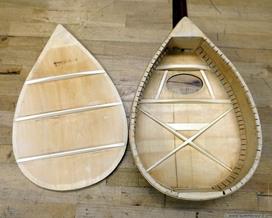It happens that I get in something other than a guitar, mandolins I have fixed to a few pieces over the years. This GammelMando'n was an early flat-bottomed Levin mandolin from 1924. Older mandolins are mostly ball mandolins, nothing wrong with them, but not popular nowadays with their globular back. The round shape is a bit awkward to handle both when playing and when storing the instrument. Flat-bottomed mandolins were first made in the United States and it took until the 1920s and 1930s before they became common in Europe, nowadays almost only flat-bottomed mandolins are made.
The lid had a huge crack and the lid was submerged around the stable. The tuning screws were not in the best condition and a couple of knobs were missing. The thick plectrum cover had a number of cracks and the straps were small and worn. Originally this mandolin was the closest chocolate brown, but the brown had sun-bleached and there was the red color. The original color remained behind the tuning screws and under the string holder.
Has always had problems with pressing ("floating") stalls on a flat lid. They always sound best when the rib is so small that it almost breaks. In addition, the pressure from the stable is high and depends on the angle of refraction of the string over the stable. The best solution is to have a cut lid like on a violin where the arch takes care of the pressure, then you get a strong lid that is light at the same time. The ultimate mandolin was made by Gibson in the 1920s, they have only a minimal bar below the sound hole and a cut lid with arch.
Have tested several different ribs with varying success, but nowadays I simply make a cross in the lid below the sound hole. The stable has no twisting torque to take into account, just pressure. With the cross you get the chance to curve up the flat lid and you can make the ribs a little lighter than with variants of ladder bracing. Of course it is still difficult to know exactly how strong the ribbing must be, the closer to the breaking point the better the sound…
The mandolin got a smaller but solid carbon fiber rod in the neck and new ribs. The bottom was thinned when it was well thick and the bottom ribs were made smoother. Reversed the intersection when the first variant felt too small, did not dare to keep it, but made a new and a little more powerful. The picture shows the first smaller junction. Maybe I was wrong, who knows?
It went well both to loosen the celluloid bond around the bottom and to glue it back. The thick plectrum cover broke when I loosened it, it was glued directly to the spruce lid. Replaced it with a thinner pickup cover in black ABS plastic. The fretboard in braz rosewood re-banded with fatter brass bands. New tuning screws with matching black knobs were fitted. The originals for the saddle and stable were retained, the saddle was shimmed up with legs and the stable was modified with a hatch in the middle on the underside. Stables with two "legs" sound better than a stable that rests with the entire surface of the lid, the tone becomes more open and more varied.
Installed a K&K with two sensors, the sensors were glued to the spruce plate under each "foot" in the stable. Worked well, the risk with a contact mic inside with a pressing stall is otherwise that the tone can become a bit "hollow" with too much reverb. Added a 0.10 set of mandolin strings, but I think it works well even with 0.11 with the new slightly stronger ribs and the low stable. Puts the string height of approx. 1.2 mm at the 12th band for all strings (can be a little lower for the unspun) and the spun strings 0.3 mm above the 1st band, 0.2 mm for the unspun 1st band.
The entire mandolin was given a layer of clear spirit varnish which was then matted down with the finest steel wool and polished up to half mat with a linen cloth. You can if you want to hand-polish such an alcohol varnish further with a dry cloth, but then the varnish must have dried a month or so and hardened more. The friction heat at the polishing causes the lacquer to melt in the surface and become glossier.
This Levin model is nice and beautiful. It is easy to play with nail straight neck, sounds good and the bottom sings along with its smaller ribbing and thickness. Not quite as good of course as my chocolate brown A0 Gibson mandolin from 1921 which has a darker tone, but it is hard to beat! 🙂







